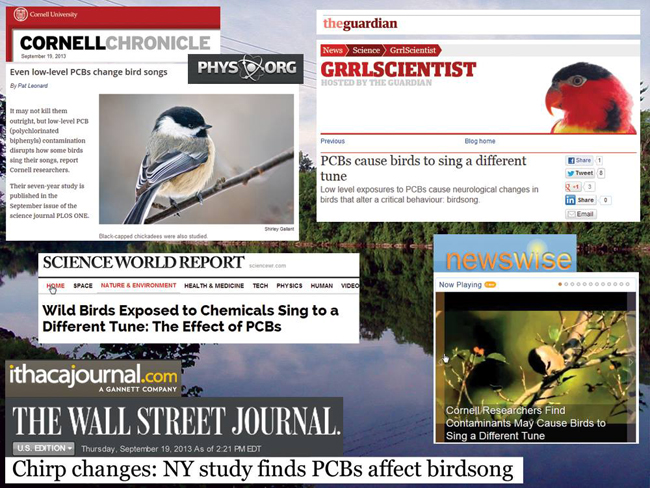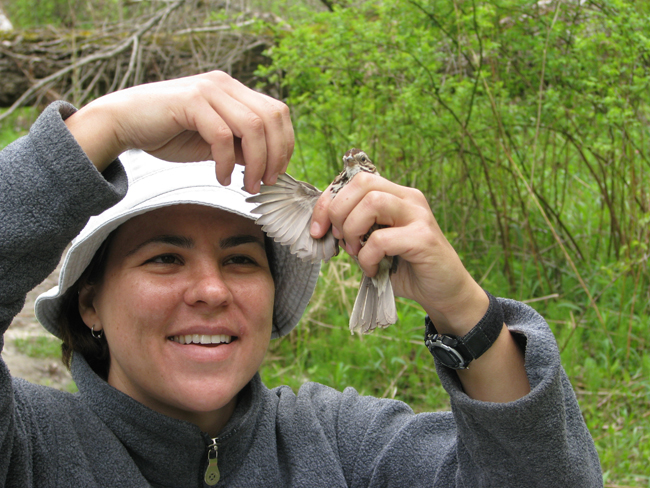NY Sea Grant-funded project shows changes in birdsong may be caused by non-lethal levels of PCBs in Hudson River sediment
Contact:
Barbara A. Branca, NYSG Communications Manager, E: Barbara.Branca@stonybrook.edu, P: 631-632-6956

Within days of being published in the journal PLOS ONE in mid-September,
the findings of this New York Sea Grant-funded Cornell Lab of
Ornithology research generate many tweets (no pun intended) and posts
on, respectively, Twitter and Facebook. The project also garnered a
great deal of news coverage from print and online sources, wherein
investigators elaborated on their study of songbirds that exhibited
inconsistency in their songs. Could this occurrence be caused by
contaminants that persist in the sediments of the Hudson River region?
Read on for more on this project's findings, including video and audio
clips.
Stony Brook, NY, September 18, 2013 - In an article published today in the journal PLOS ONE (click here), researchers at Cornell University’s Laboratory of Ornithology report that in some environments, songbirds exhibit inconsistency in their songs which may be caused by non-lethal levels of contaminants that persist in the sediments of the Hudson River region.
The research reported in “The Effect of Polychlorinated Biphenyls on the Song of Two Passerine Species,” was funded by New York Sea Grant, a joint program of the State University of New York, Cornell University and the National Oceanic and Atmospheric Administration.
Lead author Dr. Sara DeLeon, working with principal investigator Dr. Timothy J. DeVoogd and co-investigator Dr. Andre A. Dhondt, studied songbirds that nest along the Hudson River valley, a region with legacy levels of PCBs as a result of decades of electronics manufacturing upriver. Polychlorinated biphenyls (PCBs) are synthetic chemical pollutants with demonstrated detrimental toxic and developmental effects on humans and wildlife.
"Dr. DeLeon's work would have brought a smile to the face of Rachel Carson,” said William Wise, Interim Director of New York Sea Grant. “This type of dedicated field research can tease out the impact of organic contaminants in the environment on creatures that are known to all of us. Sara and colleagues are drawing the connections between contaminant, animal behavior and, ultimately, a population's health."

For her doctoral thesis at Cornell University’s Laboratory of Ornithology, Dr. Sara DeLeon studied birdsong as an indicator of effects of exposure to sublethal levels of contaminants such as PCBs (polychlorinated biphenyls) in the environment of the Hudson Valley. Photo courtesy of Sara DeLeon
Songbirds feed their young PCB-contaminated aquatic insects as their main food source. Some birds continue eating insects throughout life, thus increasing PCB ingestion if they live in contaminated areas. The research team non-lethally investigated total PCB loads, congener specific PCB profiles, and songs of black-capped chickadees (Poecile atricapillus) and song sparrows (Melospiza melodia) along a historical PCB gradient at the Hudson River in New York State.
Key among the team’s findings is that song disruption is tied to specific types of PCBs—there are 209 variations, differentiated by the positioning and number of chlorine atoms. DeLeon tested 41 of these variations to isolate their effects.
According to the authors, “Our results indicate that black-capped chickadees and song sparrows have higher total blood PCBs in regions with higher historic PCB contamination. The two bird species varied substantially in their congener-specific PCB profiles; within sites, song sparrows showed a significantly higher proportion of lower chlorinated PCBs, while black-capped chickadees had higher proportions of highly chlorinated PCBs.” Analysis of blood samples from black-capped chickadees showed greater variability in song with a change in the “glissando” ratio of the first note of their two-note song, “fee-bee, fee-bee.” Song sparrows, with much longer songs, also showed ‘high performance trills’ that may be the result of other types of PCB molecules that are less toxic. In areas of PCB pollution, the species-specific identity signal in black-capped chickadee song varied significantly, while variation in song sparrow trill performance was best predicted by the mono-ortho PCB load.
“Thus, PCBs may affect song production, an important component of communication in birds,” the authors report. In conclusion, “The ramifications of changes in song quality for bird populations may extend the toxic effects of environmental PCB pollution.”
Nordica Holochuck, New York Sea Grant’s Hudson Estuary specialist said, “This research is of great interest to stakeholders in the Hudson Valley as the effects of PCBs, even non-lethal ones, continue to be discovered.”
“Effects of PCBs are extremely complicated,” says co-author André Dhondt, director of Bird Population Studies at the Cornell Lab of Ornithology. “What this demonstrates is that most previous PCB studies may not give us the whole picture because they did not look at the specific type of PCB involved but just measured overall levels. What Sara did was not easy. She found effects on the song and wanted to do more than just document that there was an effect, but to isolate what was causing it.”
“Contaminants last a long time and are pervasive,” says DeLeon. “We have to take that into account when we study species in these disturbed environments and be aware of how environmental changes are affecting them.” Coauthors include Rayko Halitschke, Ralph S. Hames, André Kessler, DeVoogd and Dhondt.
More photos and mp3s of birdsongs are available via "Are Birds Singing a Different Tune?," a related feature story in the Fall 2012 issue of New York Coastlines, NYSG's flagship publication. These mp3s, as well as a related video, are also featured below ...
On YouTube: Birdsong Altered by Low-level PCBs (September 2013)
Video by: Cornell Lab of Ornithology
Audio: Bird Songs
Files courtesy of Sara DeLeon
PCBs with a different molecular configuration appear to accumulate in
the brains of song sparrows, increasing the performance of the long
trills in their songs.
If you don't see the player above, it's because you're using a non-Flash device (eg, iPhone or iPad). You can download the mp3 file by clicking here (mp3). It may take a few minutes to download, so please be patient.
If you don't see the player above, it's because you're using a non-Flash device (eg, iPhone or iPad). You can download the mp3 file by clicking here (mp3). It may take a few minutes to download, so please be patient.
These two files compare a "consistent" call of a black-capped chickadee
with a less consistent call which is associated with exposure to
sublethal level of contaminants.
If you don't see the player above, it's because you're using a non-Flash device (eg, iPhone or iPad). You can download the mp3 file by clicking here (mp3). It may take a few minutes to download, so please be patient.
If you don't see the player above, it's because you're using a non-Flash device (eg, iPhone or iPad). You can download the mp3 file by clicking here (mp3). It may take a few minutes to download, so please be patient.
More Info: New York Sea Grant
New York Sea Grant (NYSG), a cooperative program of Cornell University
and the State University of New York, is one of 33 university-based
programs under the National Sea Grant College Program (NSGCP) of the
National Oceanic and Atmospheric Administration (NOAA). The NSGCP
engages this network of the nation’s top universities in conducting
scientific research, education, training and extension projects designed
to foster science-based decisions about the use and conservation of our
aquatic resources. Through its statewide network of integrated
services, NYSG has been promoting coastal vitality, environmental
sustainability, and citizen awareness about the State’s marine and Great
Lakes resources since 1971.
For updates on Sea Grant activities: www.nyseagrant.org has RSS, Facebook, Twitter, and YouTube links. NYSG also offers a free e-list sign up via www.nyseagrant.org/coastlines for NY Coastlines, its flagship publication, and Currents, its e-newsletter supplement, each distributed several times a year.